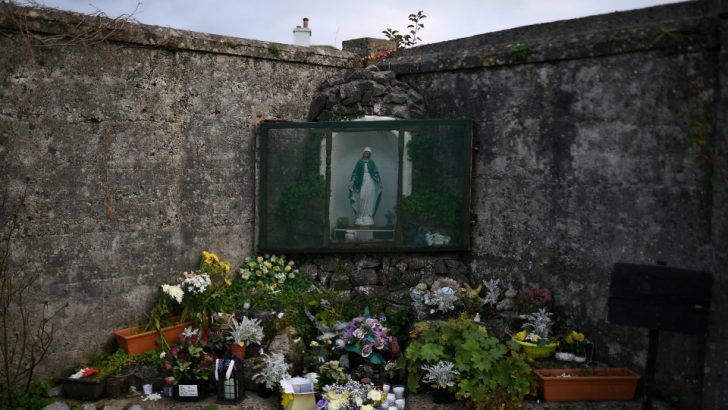The latest Tuam interim report invites a host of questions, writes David Quinn
The latest interim report by the Commission of Investigation into Mother and Baby Homes was issued last week. This new report is concerned mainly with finding out what happened to the dead infants and children in the various institutions under investigation.
In some cases, it can say with certainty where the remains are buried because proper burial records were kept. In other cases, no such records were kept.
The spotlight once again returned to the home in Tuam, which closed 58 years ago, and to a lesser extent the one in Bessborough, Cork.
If you will cast your mind back to when this story first broke in 2014, headlines around the world read, “800 babies found in a septic tank”. It was established by the commission last year that this is not in fact true. The tank is empty.
But there are many bodies in a separate underground structure that may be a disused sewage system of some sort. It appears to have been used as a burial chamber from 1937 until 1961 when the Tuam home closed. What happened to bodies before then is unknown.
Responsible
The commission points out that neither the Bons Secour Sisters, who ran the home, nor Galway County Council, who were officially responsible for it, knew the answers.
The commission is clearly very frustrated that it still does not know for certain how the bodies of the dead infants and children were buried.
It thinks some people must know more. The very last paragraph of its latest report says: “The commission considers that there must be people in Tuam and the surrounding area who know more about the burial arrangements and who did not come forward with the information.”
It is similarly frustrated about Bessborough. Hundreds of children died there over the decades but the Congregation of the Sacred Hearts of Jesus and Mary who ran it does not know where the children are buried.
The commission says it “finds this very difficult to comprehend as Bessborough was a mother and baby home for the duration of the period covered by the Commission (1922–1998) and the congregation was involved with it for all of this time”.
So, either the sisters are lying, or they genuinely don’t know.
The commission thinks the bodies are buried somewhere in the 200 acres of the original institution but cannot find where.
Almost 800 children died at Bessborough and another 522 born to unmarried mothers died in St Finbarr’s hospital. We do not know for sure where the children from St Finbarr’s are buried either. Many of those children were transferred to the hospital from Cork County Home, which was not run by any religious congregation.
The Commission points out: “In the majority of cases, the burial of a child of a public patient was arranged by the administrators of Bessborough or Cork District Hospital/St Finbarr’s, most likely in conjunction with the health authorities who were paying for the mother and child.”
Certainty
The Commission thinks the children who died at St Finbarr’s are buried at Carr’s Hill cemetery, Cork.
In several cases the new report can say with total certainty or a high degree of certainty where the bodies are buried.
For example, the children who died in the Protestant-run Bethany Home are to be found in Mount Jerome Cemetery in Dublin.
The children who died in St Patrick’s on the Navan Road (formerly called Pelletstown) are buried in Glasnevin Cemetery.
In the case of Castlepollard, the commission says “it has no reason to doubt that the majority of children” who died there are in a burial ground in an old walled garden of the institution.
At Sean Ross, where over 1,000 children died between 1931 and 1969, there is “a designated child burial ground in the grounds of the institution”. A study of the site is currently underway.
Certain other aspects of the report are worth noting.
For example, we read that in the Tuam home an unspecified number of the children were from married parents who could not look after them for one reason or another. Some of those children will have died also. Were they taken away by their mothers and buried separately by them, or were they buried with the rest of the children, mostly likely in the underground chamber?
The report looks at how children in the general community were buried in the first half of the last century. It says it “had difficulty in finding solid evidence on the subject”.
This seems incredible. Surely there are social historians who know how children in general were buried in say, 1940, and what kind of burial records exist?
Buried informally
One priest told me that children who died before the age of seven (the age of reason) were often buried informally in those days because, if they were baptised, they were considered to have died in a state of grace and therefore did not need prayers said for them. The commission can surely discover this, or perhaps someone with suitable expertise can make a submission of their own to the commission about the matter?
The commission should also look at how the poor in general were buried in those decades. Very many went into unmarked graves because they could afford nothing else.
The international context must also be examined. For example, in Britain, mother and baby homes operated until the 1970s and only a minority were run by the Catholic Church.
In the US to this day, bodies of the poor who no-one claims are still sometimes buried in huge unmarked graves. One in New York, called Hart Island, contains over one million bodies, many of them babies.
The commission says the final report will look at “the social and economic context of the times”. This will be vital to arriving at a proper understanding of what happened.


 David Quinn
David Quinn Tuam Mother and Baby Home
Tuam Mother and Baby Home